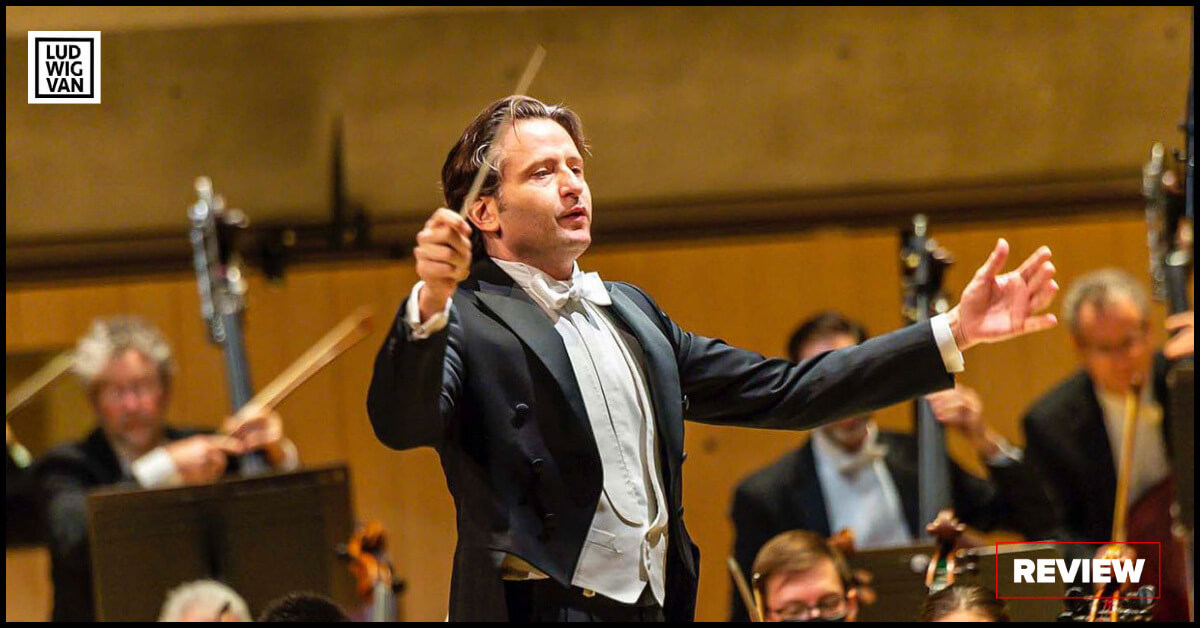
Toronto Symphony Orchestra, with Music Director Gustavo Gimeno. Roy Thompson Hall. Nov. 10. Repeats Nov. 11 & 13. Details available [HERE].
No balloons. No Cake. No Fireworks. But there was a party last night at Roy Thomson Hall. The occasion was a dual-fold return after a 21-month absence, and conductor Gustavo Gimeno’s official debut as Music Director at the Toronto Symphony Orchestra. A welcome return.
The mood was one of relief that the TSO survived it all, and an appreciation that we can all see each other in the flesh. After all, going to concerts is a social experience, and I would argue a vital one.
After a late start, the first few notes of a fanfare by Anthony Barfield reminded us what we’ve been missing. They were symbolic and heavy. The piece, Invictus — Latin for “unconquered”, is from an imaginative composer better known in the brass community in the US. The piece combined classical, gospel, hip-hop, jazz, and the kitchen sink. Being a reflection of the time that inspired it, COVID-19 and strife amid the Black Lives Matter protests sweeping the US at the time, it evoked the Summer of 2020. It felt unsettled, worried — unfinished even.
The rest of the program continued to reveal more about Gustavo Gimeno’s musical ideas, and an orchestra willing to trust them.
There was a clean, small course performance of Haydn’s Overture to the opera L’isola disabitata (The Desert Island), Hob. la:13. Despite a smaller-sized orchestra, the sound was surprisingly vast. They used a more conversational seating arrangement, with second violins seated opposite the first violins. The result was playful and bright. They looked like an orchestra relishing the experience.
Then there was also Schubert’s Symphony No. 5. With Mozart on the brain, this was Schubert offering a glimpse into a world that might have been if Beethoven hadn’t shown up at the party with a case of red wine and a new vision for what a symphony could do. Gimeno allowed the four movements to unfold patiently — slow in today’s standard, but just right for 1816. The TSO sounded balanced throughout and relatively unfazed with the clapping between movements from an out-of-practice audience.
The best of the night was all about Hindemith’s Concert Music for Strings and Brass. Composed in 1930, the Op. 50 is arguably the most underrated of his three Konzertmusik works. Over two movements, Gimeno coaxed a Hitchcockian flavour from the score. Jolting between dark, sinister strings and busy, flourishing textures, the piece took the shape of a hurried city at night.
At the onset of this review, I said there was a feeling of relief during the concert. Thinking about it more, I could not help but feel a sense of gratitude. A realisation that the existence of our city orchestras, Toronto and elsewhere, are not infallible.
For now, thanks to some fortitude, we have a lot to look forward to.
#LUDWIGVAN
Get the daily arts news straight to your inbox.
Sign up for the Ludwig van Daily — classical music and opera in five minutes or less HERE.
- THE SCOOP | Royal Conservatory’s Dr. Peter Simon Awarded The Order Of Ontario - January 2, 2024
- THE SCOOP | Order of Canada Appointees Announced, Including Big Names From The Arts - December 29, 2023
- Ludwig Van Is Being Acquired By ZoomerMedia - June 12, 2023



